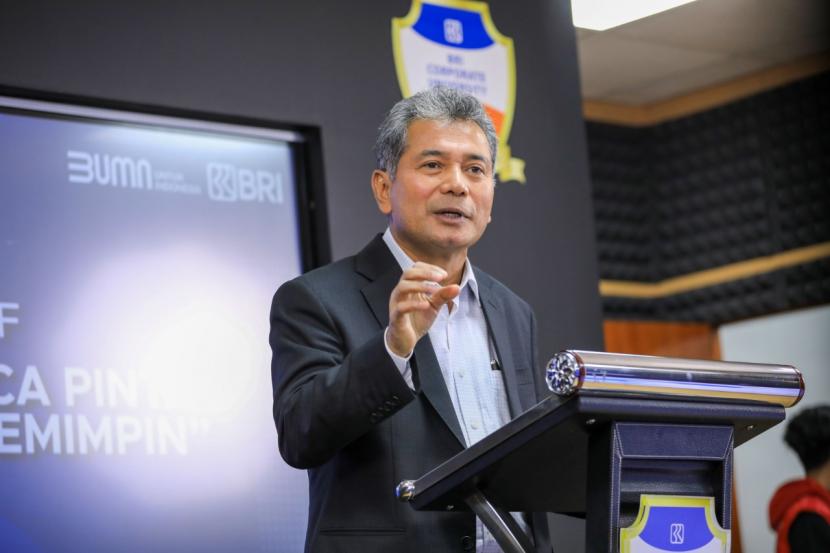REPUBLIKA.CO.ID, JAKARTA -- PT Bank Rakyat Indonesia (Persero) Tbk (BRI; IDX code BBRI) succeeded in closing 2023 with brilliant performance and sustainable growth.
At the presentation of the 2023 financial performance in Jakarta (Wednesday, Jan.31, 2024), President Director of BRI Sunarso revealed that consolidated company assets grew 5.3 percent yoy to IDR 1,965.0 trillion. BRI also posted a profit of IDR 60.4 trillion (3.9 billion USD) or grew 17.5 percent year on year (yoy).
"BRI has once again proven that with the right strategic response, the company can turn challenges into opportunities, and turn difficulties into convenience. Overall, BRI was becoming more resilient, stronger and more powerful. As we all felt in 2023, there were many external challenges, starting from high interest rates and inflation, uncertain geopolitical conditions, and several banks in the United States collapsing. However, BRI can get through it all with an impressive record," he said.
Sunarso also said that BRI's profits were the rights of shareholders. Through the payment of taxes and dividends, the profits worth IDR 60.4 trillion will ultimately return to the state as the majority shareholder. Furthermore, the funds were used for the benefit of the Indonesian people through various government programs.
"That was clear evidence that state-owned companies which have the functions of agent of development and value creator can simultaneously carry out economic and social value roles simultaneously," he added.
The main pillars of BRI's impressive performance until the end of 2023 include credit distribution which grew double digits and above the national banking industry, maintained credit quality, adequate collection of Third Party Funds (DPK) with a focus on low-cost funds (CASA). Likewise, efficiency continues to increase, the result of the digital transformation carried out by BRI.
In terms of the intermediation function, until the end of December 2023, BRI succeeded in encouraging credit distribution to grow 11.2 percent yoy to IDR 1,266.4 trillion. This achievement was higher than the national banking industry's credit distribution of 10.4 percent yoy in 2023.
In detail, all BRI loan segments recorded positive growth. The micro segment grew 10.9 percent yoy to IDR 611.2 trillion, the consumer segment grew 13.4 percent yoy to IDR 190.0 trillion, the small and medium segment grew 8.6 percent yoy to IDR 267.5 trillion and the corporate segment grew 13.8 percent yoy to IDR 197.7 trillion. In total, BRI's MSME credit portfolio reached 84.4 percent of BRI's total credit distribution or the equivalent of IDR 1,068.7 trillion.
Ultra-micro ecosystem
BRI's success in increasing its MSME credit portfolio cannot be separated from the acceleration of new sources of growth through the integration of the ultra-micro ecosystem. By the end of December 2023, the number of ultra-micro holding customers was recorded at 37.3 million borrowers. BRI Group's success in integrating customers in the ultra-micro segment has had an impact on reducing the number of customers who do not have formal financial access.
Sunarso also shared the success of the ultra micro holding at the 2024 World Economic Forum. One of them was the empowerment of women business actors in the ultra micro segment by PNM. PNM was able to distribute IDR 41.6 trillion to 15 million female entrepreneurs through PNM Mekaar.
Quoting the official website, the financing institution in Bangladesh that received the Nobel Peace Prize in 2006, Grameen Bank, has accumulated loans to 10.5 million people. Just like PNM, the majority of Grameen Bank customers were women, reaching 97 percent.
"Therefore, PNM, which was part of Ultra Micro Holding, now deserves to claim itself as the largest lending group in the world. That was BRI Group's form of empowering underprivileged women and supporting the achievement of SDGs, especially those related to gender equality," Sunarso elabotare.
Key ratios
Not only has it succeeded in accelerating credit distribution to above the achievements of the national banking industry, BRI has also been able to maintain the quality of the credit distributed. It was recorded that BRI's non-performing loan (NPL) until the end of December 2023 was under control at the level of 2.95 percent with NPL Coverage of 229.09 percent.
Meanwhile, BRI's Loan at Risk (LAR) was recorded at 13.8 percent at the end of December 2023. This figure has decreased significantly compared to BRI's LAR at the peak of COVID in September 2020, namely 29.8 percent. "BRI's ability to manage NPLs below 3 percent proved that risk management principles has been implemented well. Moreover, the majority of BRI's portfolio was in the MSME segment," Sunarso said.
In terms of Third Party Funds (DPK), until the end of December 2023 BRI succeeded in collecting DPK of IDR 1,358.3 trillion or grew 3.9 percent yoy. This achievement was also better than the national banking industry's DPK which grew 3.8 percent yoy at the end of December 2023.
BRI's DPK collection was still dominated by low-cost funds (CASA) with a percentage reaching 64.4 percent or the equivalent of IDR 874.1 trillion. In the midst of tight national banking liquidity as a result of the era of high interest rates, BRI succeeded in maintaining its liquidity ratio at an adequate level.
BRI recorded a credit disbursement to funds collection ratio or LDR at the end of December 2023 of 84.2 percent. Apart from that, BRI was also able to maintain the capital adequacy ratio (CAR) at an adequate level of 27.3 percent. With adequate liquidity and capital conditions, BRI still has room for better growth in 2024.


